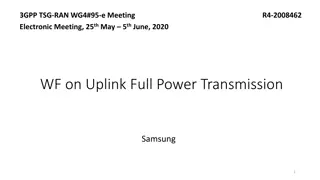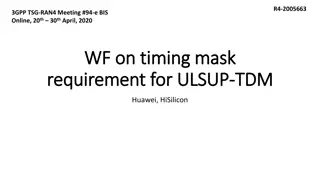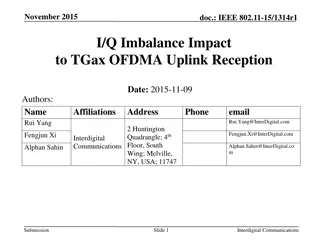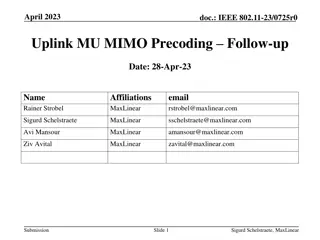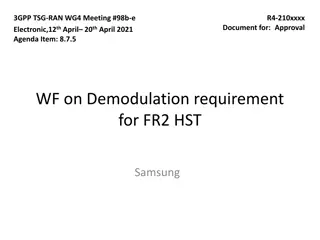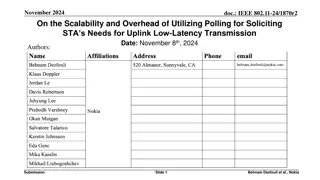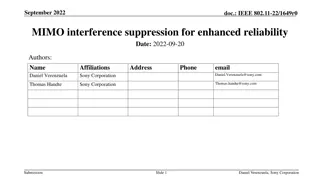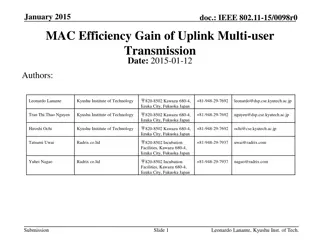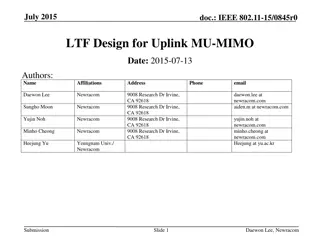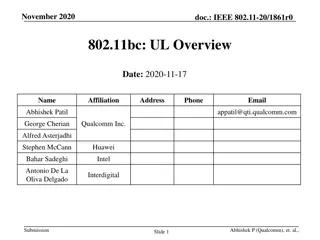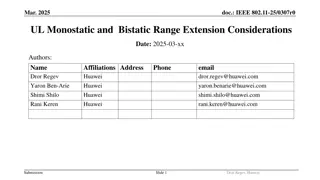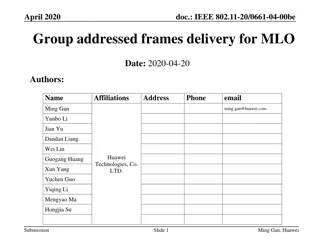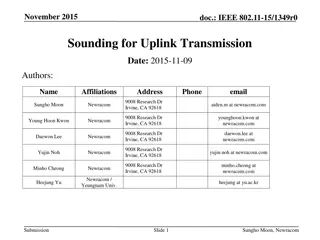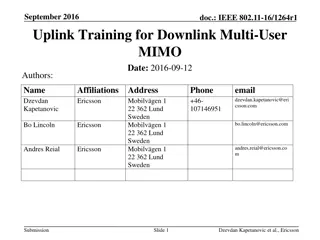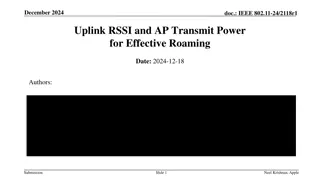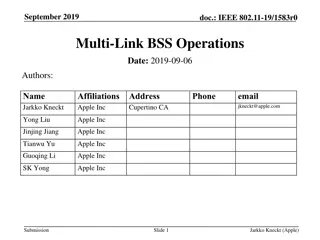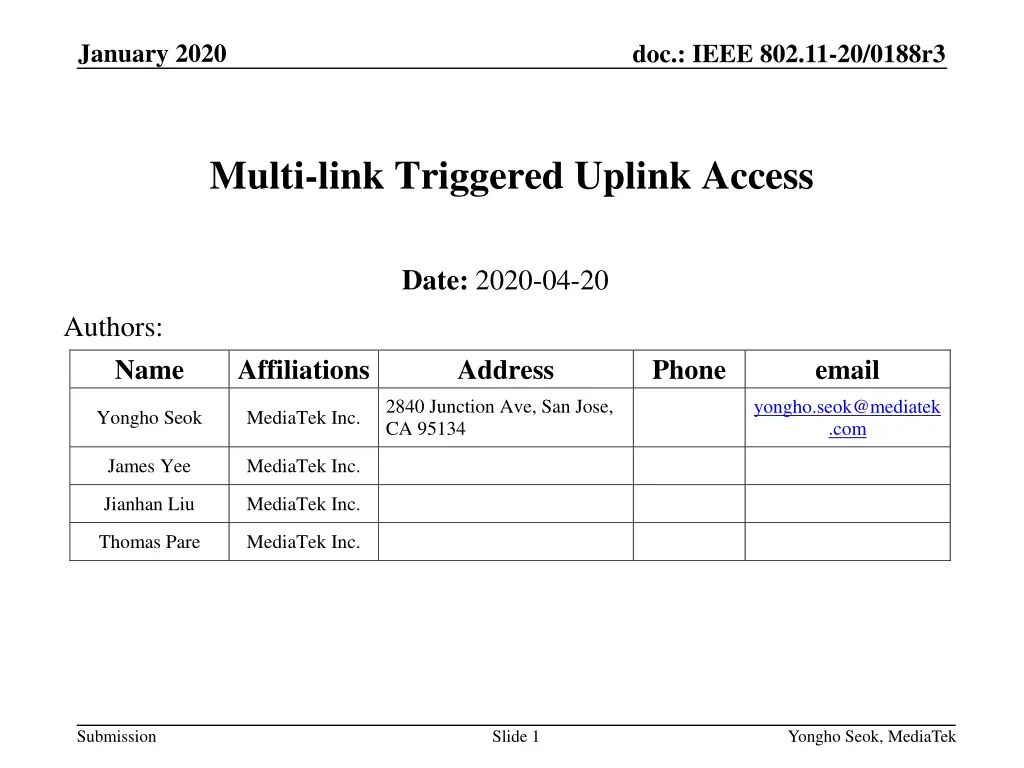
IEEE 802.11-20/0188r3 Multi-link Uplink Access
Explore the challenges of simultaneous transmission and reception in multi-link setups, focusing on in-device coexistence interference and solutions for triggered uplink access. Learn about constrained multi-link transmission requirements and synchronization needs for effective communication.
Download Presentation

Please find below an Image/Link to download the presentation.
The content on the website is provided AS IS for your information and personal use only. It may not be sold, licensed, or shared on other websites without obtaining consent from the author. If you encounter any issues during the download, it is possible that the publisher has removed the file from their server.
You are allowed to download the files provided on this website for personal or commercial use, subject to the condition that they are used lawfully. All files are the property of their respective owners.
The content on the website is provided AS IS for your information and personal use only. It may not be sold, licensed, or shared on other websites without obtaining consent from the author.
E N D
Presentation Transcript
January 2020 doc.: IEEE 802.11-20/0188r3 Multi-link Triggered Uplink Access Date: 2020-04-20 Authors: Name Affiliations Address Phone email 2840 Junction Ave, San Jose, CA 95134 yongho.seok@mediatek .com Yongho Seok MediaTek Inc. James Yee MediaTek Inc. Jianhan Liu MediaTek Inc. Thomas Pare MediaTek Inc. Submission Slide 1 Yongho Seok, MediaTek
January 2020 doc.: IEEE 802.11-20/0188r3 Recap: Synchronous Multi-link Transmission When a STA simultaneously transmits and receives frames on multi-link, it may have some in-device coexistence (IDC) interference. When simultaneous Tx and Rx is happened between 2.4 GHz band and 5 GHz band, the IDC interference is probably negligible. But, the IDC interference caused by simultaneous Tx and Rx between 5 GHz band and 6 GHz band may be significantly problematic worse depending on some implementation capability like the RF filter performance. Submission Slide 2 Yongho Seok, MediaTek
January 2020 doc.: IEEE 802.11-20/0188r3 Multi-link Triggered Uplink Access (TUA) An AP performs an independent EDCA channel access on each link with its own EDCA parameters (CWmin, CWmax, AIFS, CW, and Retry Counter). After obtaining a TXOP, the AP sends the Trigger frame and the STAs responds with the EHT TB PPDU. On each link, the PPDUs carrying the Trigger frame and the EHT TB PPDU can be independently encoded into one of frequency segments. Back-off Trigger Block ACK Trigger AP 9 8 7 6 5 4 3 2 1 0 6GHz STA EHT TB PPDU EHT TB PPDU Back-off Trigger Block ACK Trigger AP 5 4 3 2 1 0 5GHz STA EHT TB PPDU EHT TB PPDU Submission Slide 3 Yongho Seok, MediaTek
January 2020 doc.: IEEE 802.11-20/0188r3 Constrained Multi-link TUA But, when the STA has the IDC interference issue, the AP shall not schedule to the STA the PPDU carrying the trigger frame while the STA is responding with an EHT TB PPDU. Error by IDC interference Back-off Trigger Block ACK Trigger AP 8 7 6 5 4 3 2 1 0 6GHz STA EHT TB PPDU No Response Back-off Trigger Block ACK Trigger AP 5 4 3 2 1 0 5GHz STA EHT TB PPDU EHT TB PPDU Submission Slide 4 Yongho Seok, MediaTek
January 2020 doc.: IEEE 802.11-20/0188r3 Constrained Multi-link TUA Synchronization requirement [1] A difference between the ending times of PPDU transmissions shall be less than SIFS - (10% aSlotTime). Because a minimum inter-frame space is not less than SIFS, Tx and Rx are not overlapped. A margin of 10% aSlotTime considers the SIFS accuracy of the IEEE 802.11-2016 spec. Difference between the ending times of the transmissions is less than SIFS - (10% aSlotTime). Trigger MAC Padding PHY Padding AP PE (CS Required = 0) 6GHz SIFS STA EHT TB PPDU MAC Padding PHY Padding Trigger PE AP (CS Required = 0) 5GHz SIFS STA EHT TB PPDU Submission Slide 5 Yongho Seok, MediaTek
January 2020 doc.: IEEE 802.11-20/0188r3 Constrained Multi-link TUA Additionally, a STA s IDC interference can change the carrier sense (CS) of another link to a busy state (e.g., greater than ED threshold) while the STA is transmitting an EHT TB PPDU. In such case, the STA may not respond to the Trigger frame with the CS Required field set to 1. Difference between the ending times of the transmissions is less than SIFS - (10% aSlotTime). Trigger MAC Padding PHY Padding AP PE (CS Required = 1) 6GHz SIFS STA EHT TB PPDU MAC Padding PHY Padding Trigger PE AP (CS Required = 1) 5GHz STA Interference leakage cause the CS status to a busy state. Submission Slide 6 Yongho Seok, MediaTek
January 2020 doc.: IEEE 802.11-20/0188r3 Constrained Multi-link TUA So, when the AP sends to the STA a PPDU containing the Trigger frame with the CS Required field set to 1, the AP should meet the following additional requirement. The difference between the ending time of the soliciting PPDU and the starting time of the first solicited PPDU that is sent immediately after the soliciting PPDU is greater than or equal to aCCATime (TBD). aCCATime (e.g., 4 s, 8 s) can be predetermined in the spec. Or, each STA can signal its aCCATime requirement to the AP. The time difference between the soliciting PPDU and the solicited PPDU is greater than or equal to aCCATime. Trigger MAC Padding PHY Padding AP PE (CS Required = 1) 6GHz SIFS STA EHT TB PPDU MAC Padding PHY Padding Trigger PE AP (CS Required = 1) 5GHz SIFS STA EHT TB PPDU Submission Slide 7 Yongho Seok, MediaTek
January 2020 doc.: IEEE 802.11-20/0188r3 References [1] https://mentor.ieee.org/802.11/dcn/19/11-19-1305-00- 00be-synchronous-multi-link-operation.pptx Submission Slide 8 Yongho Seok, MediaTek
January 2020 doc.: IEEE 802.11-20/0188r3 Straw Poll 1 Do you support the following PPDU transmission restriction in the MLO? When an AP MLD aligns the ending time of DL PPDUs, the alignment requirement (i.e., the difference restriction between the ending times of transmitting DL PPDUs) is determined independent of the frame contained in the DL PPDUs. Yes/No/Abstain/No Answer: 24/22/29/14 (Failed) Submission Slide 9 Yongho Seok, MediaTek
January 2020 doc.: IEEE 802.11-20/0188r3 Straw Poll 2 (Backup) Do you support the following PPDU transmission restriction in the MLO? An AP in the AP MLD should not send a Trigger frame with the CS Required subfield set to 1 to a STA in a non-STR STA MLD, when a response PPDU transmission from other STAs in the same non-STR STA MLD can be started before TBD (aCCATime) time has expired after the PPDU containing the Trigger frame. Submission Slide 10 Yongho Seok, MediaTek
January 2020 doc.: IEEE 802.11-20/0188r3 Backup Submission Slide 11 Yongho Seok, MediaTek
January 2020 doc.: IEEE 802.11-20/0188r3 Synchronization Requirement in 11-20/433 Basically, 11-20/433 presumes that the STA on the link2 responding the Trigger frame with the CS Required equal to 1 may need to perform the CCA until just before the TxRx turnaround. In such case, if a difference between the ending times of the PPDUs carrying the Trigger frames with the CS Required equal to 1 is less than TxRx Turnaround time, the interference leakage makes the STA2 to not transmit the TB PPDU response. Submission Slide 12 Yongho Seok, MediaTek
January 2020 doc.: IEEE 802.11-20/0188r3 Synchronization Requirement in 11-20/433 In this case, the solution is that a difference between the ending times of the PPDUs carrying the Trigger frames with the CS Required equal to 1 shall be less than the TxRx Turnaround time. Because TxRx Turnaround time is less than 2us or 4us (from 11-20/433), this synchronization requirement is very tight. Submission Slide 13 Yongho Seok, MediaTek
January 2020 doc.: IEEE 802.11-20/0188r3 Synchronization Requirement in 11-20/188 In 11-20/188, we think that the STA is not necessary to perform the CCA until just before the TxRx turnaround. The CCA can be started immediately after receiving the Trigger frame. But, the exact timing is an implementation issue. Even though the MAC processing delay is considered until start the CCA, we think that all required time until finishing the CCA may be less than aSlotTime (9us). Submission Slide 14 Yongho Seok, MediaTek
January 2020 doc.: IEEE 802.11-20/0188r3 Synchronization Requirement in 11-20/188 In such case, the interference leakage issue is happened when a difference between the ending times of the PPDUs carrying the Trigger frames with the CS Required equal to 1 is greater than or equal to the SIFS-CCATime. And, the CCATime may be less than aSlotTime (= aCCATime + aMACProcessingDelay + aRxTxTurnaroundTime + aAirPropagationTime). Submission Slide 15 Yongho Seok, MediaTek
January 2020 doc.: IEEE 802.11-20/0188r3 Synchronization Requirement in 11-20/188 The solution of 11-20/188 is that a difference between the ending times of the PPDUs carrying the Trigger frames with the CS Required equal to 1 shall be less than the SIFS-CCATime. When we consider the CCATime to 8us, this synchronization requirement is not much tight. We can apply 8us synchronization requirement to all scenarios. Submission Slide 16 Yongho Seok, MediaTek
January 2020 doc.: IEEE 802.11-20/0188r3 Summary In a conclusion, 11-20/433 and 11-20/188 are addressing the same problem and saying almost same solution. But, two contributions have a different view on when the CCA mechanism during the SIFS before sending the TB PPDU is triggered and finished. But, this is a fully implementation issue. But, while considering that the CCA is performed after D1+M1, we don t think that too strict synchronization requirement (as in 11-20/433) is not needed. Submission Slide 17 Yongho Seok, MediaTek

